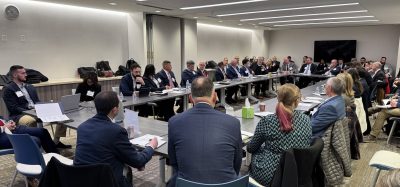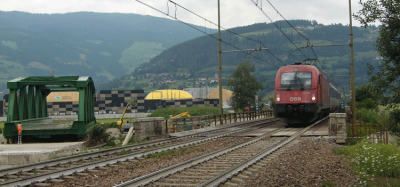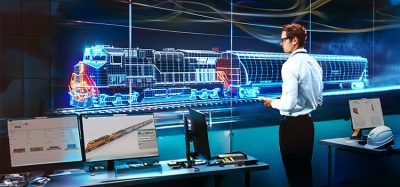Successful première of the RPM-RS-900
Posted: 6 June 2007 | | No comments yet
On 15 April 2007, the RPM-RS-900 from the SPTIZKE Group celebrated its construction première in Germany. For the first time, the machine works to improve the formation, cleaning and recycling of ballast – all in a single machine complex. Renewing the substructure of tracks is now performed by 200 metres of state-of-the-art high performance technology.
On 15 April 2007, the RPM-RS-900 from the SPTIZKE Group celebrated its construction première in Germany. For the first time, the machine works to improve the formation, cleaning and recycling of ballast – all in a single machine complex. Renewing the substructure of tracks is now performed by 200 metres of state-of-the-art high performance technology.
On 15 April 2007, the RPM-RS-900 from the SPTIZKE Group celebrated its construction première in Germany. For the first time, the machine works to improve the formation, cleaning and recycling of ballast – all in a single machine complex. Renewing the substructure of tracks is now performed by 200 metres of state-of-the-art high performance technology.
First implementation in northern Germany
The renewal of 1,300 metres of formation protection layer was the task given to the RPM-RS-900 when it was first used on site in April 2007. SPITZKE AG, one of the leading track construction companies in Germany, renewed a total of 9,000 meters of track on the dual-track route between Glückstadt and Itzehoe in northern Germany. This major project consisted of replacing the sleepers and tracks, cleaning the ballast and installing a formation protection layer using the assembly-line method. Here, the UM-S 2001 track-renewal train, the RM 900 S high-performance ballast screener and for the first time also the brand new RPM-RS-900 were used. This recycling, formation rehabilitation and cleaning machine was transferred according to schedule by the manufacturers Plasser & Theurer to SPITZKE AG on 31 March 2007 after successful completion on its functional construction site.
On the morning of the 15 April 2007, it was first put into operation on a SPITZKE AG site under contract by Deutsche Bahn. The target for this first layer was the installation of approximately 200 metres of formation protective layers (FPL) with a thickness of 30cm and a width of 5.30m. At 1pm on the day of the première, the 200 metre long machine stood ready in the track, and then the different parts began to move. Late in the afternoon, the site managers, technicians and machine operators were able to relax in the knowledge that everything had gone smoothly. They had achieved their goal without any hitches. The following days were similarly successful. The first construction phase for the installation of the formation protective layer was completed on 18 April 2007. The second phase followed over the next two days. During the following week, on 27/28 April, the RPM-RS-900 went into action again. At the end, it had cleaned a total of 1,300 metres of FPL and 300 metres of ballast on the Itzehoe – Glückstadt line in Schleswig-Holstein.
With the close cooperation between the SPITZKE AG project team and the manufacturer – Plasser & Theurer – the intensive preparations, commitment and enthusiasm of the entire team on this site, all played their role in the successful outcome.
As a result, the RMS-RS-900 already met up to the high expectations on its first day of use. It was shown that the SPITZKE Group was capable of using this machine to round off its scope of services with track-bound substructure improvement at the highest, state-of-the-art level. In future, the machine will be used flexibly. After all, the RPM-RS-900 can work both as a formation rehabilitation machine and as a ballast cleaning machine. It therefore meets the requirements of contractors who require FPL installation and ballast cleaning to an increasing degree.
The perfect track
The investment in this new, ultra-modern RPM-RS-900 machine complex was preceded by long-term strategic considerations at SPITZKE AG. The Group took into account the current and future track superstructure and substructure requirements. This includes primarily the ever-present demand for the ‘perfect track’. All vehicles should be able to run safely, while good ride comfort is ensured and high availability guaranteed. It is only possible to meet this requirement when every individual system part is of a high quality, and when the interaction between parts functions in the best possible way. The ‘perfect track’ depends on its individual components: the track, the sleeper, the ballast bed with plasto-elastic properties, formation protective layer and substructure. Only when the superstructure, substructure and foundation work together as a technical and physical unit can the track meet its primary requirement of transferring the forces generated by the trains and diverting them into the foundation. The superstructure and substructure must together absorb the load. The renewal of the superstructure is therefore only one side of the coin. An essential requirement for a stable, dynamic superstructure is a load-bearing substructure which is of high quality.
The improvement of the substructure
An inadequate track body substructure creates a major technical problem. It is not sufficiently able to bear the load, and endangers the stability of the superstructure and therefore of the track set. It forms a substantial part of the maintenance requirement.
The improvement of route sections with substructure problems is therefore an absolute requirement for a number of reasons. The installation of formation protective layers is known to be an effective method for increasing the load-bearing capacity of the foundation of track systems.
A perfect formation protective layer (FPL) forms a load-bearing, quiet substructure. It permits:
- Coordinated elasticity characteristics between the ballast bed and track formation
- An increase in the load-bearing capacity of the track formation
- Equal distribution of axle loads onto the track formation
- Dissipation of surface water
- Anti-freeze guarantee
- Guarantee of filter stability between the foundation and the ballast
As a result, a high-quality FPL is essential for a dynamic superstructure. There are different methods and different machines available for installing formation protective layers. The selection is made on the basis of the application, type of route and the technology required.
Nowadays, the improvement of the substructure is track-bound, and is possible using high-performance machines. They complete the work to a high degree of quality using assembly line methods, and taking into account the requirement for high availability of the route.
Recycling trend
In order to reduce the transportation and disposal of new materials to an efficient level, efforts are made to re-use existing waste materials on the site and to use geo-plastics. In connection with this, the trend for using recycling methods also applies here. During the general improvement of the substructure, the top layer of ballast is removed and re-used. The ballast is pre-cleaned using different methods (e.g. by sifting), sharpened in an impact crusher and re-installed as foundation and filling ballast.
RPM-RS-900 at state-of-the-art level
The RPM-RS-900 recycling, formation rehabilitation and cleaning machine integrates several working methods for the efficient improvement of the substructure at a state-of-the-art level. The innovative system from the manufacturer Plasser & Theurer, completes several working stages simultaneously:
- Recycling work: Ballast recycling with formation rehabilitation
- Ballast cleaning work: Ballast cleaning and the option of complete track bed renewal
- PSS recycling work: Formation rehabilitation with complete re-use of the old ballast
In other words: with this machine complex, the bed is cleaned or fully renewed, or old, removed ballast is recycled and re-installed, compacted and stabilised as the formation protection layer (FPL). The existing soil is excavated and the new FPL material laid, profiled and compacted. All operations are rail-bound and take place without blocking the adjacent track. For the contractor, this means significant reductions in blockage times and higher availability of the route with guaranteed higher quality of the result.
The advantages are of a technological, economic and environmental nature, and also affect safety during operations:
Technological advantages:
- The whole work sequence takes place solely within the track section under repair
- Substructure improvement and installation of the formation protective layer without removal of the track panel
- No loading, driving over, or damage to the substructure formation (of the newly created formation!) during works
- Short and shallow building pit with no shoring to protect the adjacent track
- Installation of the FPL with a thickness of up to 40cm and an FBL with a thickness of up to 50cm in one working stage
- If necessary, additional moistening of the FPL material, therefore optimum compaction
- Simultaneous laying of geosynthetics (non-woven geotextiles, sheeting, hard foam panels, geogrid or compound substances)
- The functions can be varied section by section: Recycling – ballast cleaning – recycling, etc.
- Combinable with each track-renewal method
Economic advantages:
- High performance – Savings of up to 50% of the new superstructure ballast or FPL material
- Reduction in track possession times compared to rehabilitation with an excavator and lorry
- High initial quality of the track with high quality reserve
- Reduced operational handicap costs
- High route availability
Environmental advantages:
- Material transport on the track, no temporary roads, no access and exit ramps, no land or crop damage, little transport on the road
- Pickup, recycling, placement, spreading and compaction of the superstructure ballast in one operation
- No stationary treatment plant required
- Alternatively: Recycling of the old track ballast to produce FPL material
Safety and operational advantages:
- Increased operational safety on the adjacent track – no extensive longitudinal track shoring required for protection purposes
- No negative impact on train traffic on the adjacent track
- To a large extent, exclusion of weather factors during the construction works
- Problem-free use, even with difficult route conditions (long cuts, high dams, urban areas or densely built-up areas, mountain routes, protected natural landscapes)
Building under the ‘rolling wheel’
The close, targeted cooperation between the contractor and the contracted company is a permanent requirement when building under the ‘rolling wheel’ The SPITZKE Group is set to meet this challenge and with the new RPM-RS-900, this will make a leading contribution to providing the best wheel-track system product quality.
At the same time, SPITZKE AG aims to achieve closer, more targeted cooperation between the contractor and the contracted company when building under the ‘rolling wheel’. With the new RPM-RS-900, the Group is making a leading contribution towards the best wheel-track system product quality.
About the author
Dipl.-Ing. Ingo Wiermann is the Engineering Director of SPITZKE AG. After his training as an architectural draughtsman, he studied Civil engineering with specialization in railway construction at the University of Applied Sciences in Hildesheim. Following this, he worked as a Site Engineer, as a Master Mechanic and as Chief of a technical location with 1,000 employees for the Deutsche Bundesbahn respectively Deutsche Bahn AG. In 1999, he joined to Spitzke GmbH. Since 2001, he has been a Member of the Board. One area of responsibility of Ingo Wiermann is the acceptance and management of major railway construction projects with mechanical track renewal using the assembly line principle; another area is the management of the track-laying machines division of SPITZKE AG. He has many years’ experience in the use and development of large superstructure machines. The latest important investment of SPITZKE Group is the RPM-RS-900 machine which was put into practice under his leadership.







